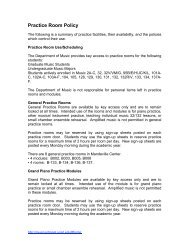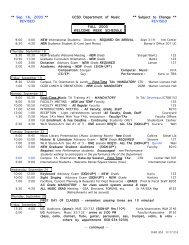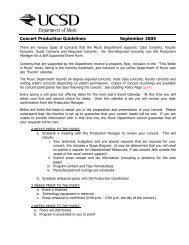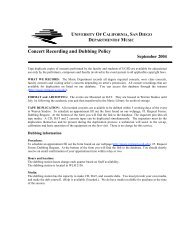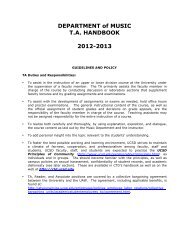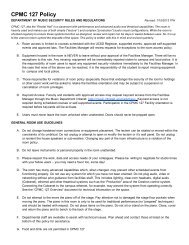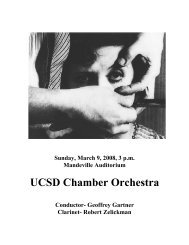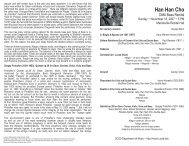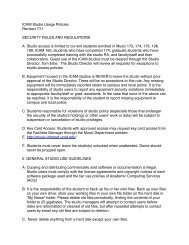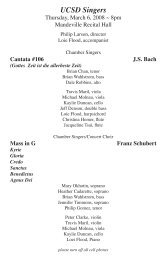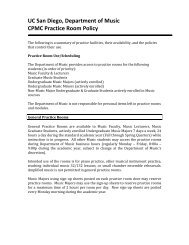Jeff Denson Contrabass Concert - Intranet
Jeff Denson Contrabass Concert - Intranet
Jeff Denson Contrabass Concert - Intranet
Create successful ePaper yourself
Turn your PDF publications into a flip-book with our unique Google optimized e-Paper software.
a dramatic sense of urgency and impact, with an almost unrelenting<br />
onslaught of atonal sixteenth notes. Nearing the end of the piece<br />
you encounter a lyrical oasis; however you quickly find that it was<br />
merely a mirage as you are thrown back into a whirlwind catapulting<br />
you to the piece’s austere finale.<br />
George Perle (b. Bayonne, N.J., 6 May 1915)<br />
Composer, theorist, and educator, Perle received his Ph.D.<br />
from New York University in 1956 as well as having studied<br />
privately with composer, Ernst Krenek in the early 1940’s. He has<br />
a profound interest in the music of the Second Viennese School<br />
(composers Arnold Schoenberg, Alban Berg, and Anton Webern),<br />
which have served as the foundation for his own musical language<br />
in which he calls Twelve Tone Tonality. This theory of twelve<br />
tone composition is described in his book Twelve Tone Tonality<br />
(Berkley 1977).<br />
Monody II for Solo Double Bass was written for (the<br />
former UCSD Professor of Double Bass) Bert Turetzky in 1962.<br />
This piece is a testament to the enormous lexicon of tone color and<br />
sonic possibilities available with the double bass. Perle explores<br />
a host of some of the various extended techniques available, both<br />
arco and pizzicato, on the instrument through his close collaboration<br />
with Mr. Turetzky, and pushes the entire register and dynamic<br />
ranges to their limits. Rhythmically, the piece is written on a free<br />
plane, by dispensing with the use of bar lines the “meter” is dictated<br />
by each phrase independently. The use of temporal and implied<br />
temporal changes exclusively throughout this piece gives it a constant<br />
feeling of unrest. By use of repetition and sudden changes in<br />
metrical grouping (i.e. triplets, sixteenth notes, quintuplets, etc.),<br />
the illusion of a tempo change is presented. This feeling of almost<br />
constant fluctuating tempi, coupled with equally as frequent timbral<br />
and dynamic changes make for an engaging work. Harmonically,<br />
the work is representative of Perle’s own personal take on the<br />
twelve tone system, while every phrase presents all twelve of the<br />
chromatic tones, they are not presented in the strict non-repeating<br />
fashion of dodecaphonic music. From violent to darkly lyrical and



